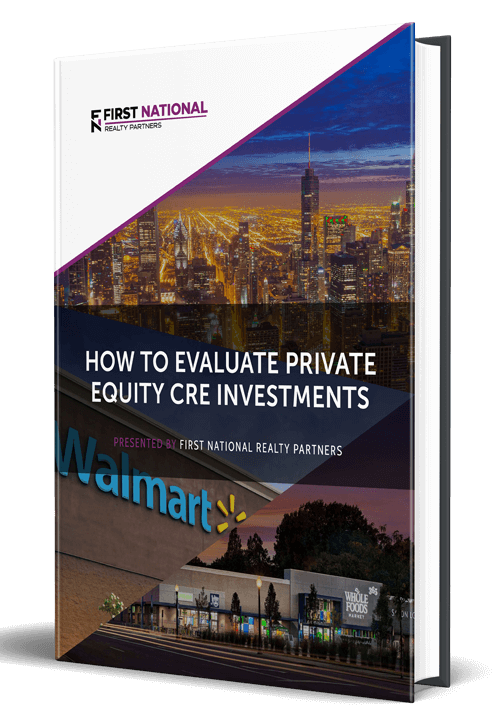There are a number of different commercial real estate property types and classes, each of which come with their own nuances. These nuances can have a significant impact on the way the property must be analyzed, underwritten, and operated so it is important to be aware of them and to incorporate them into business plans and financial projections.
To address these nuances, the commercial real estate investing community has devised a simple property type and classification system, the result of which can give investors important details about the location, build quality, and other key characteristics of the asset.
Property Types
Broadly, there are four common types of commercial real estate investment properties. Because buying and operating them can be very different so investors tend to specialize in one or two types and, in doing so, can develop a high degree of investment expertise in them. Details on each of the property types are below.
Office
Office space is designed for the unique needs of running a business. The building could be a glass and steel high-rise located in the “central business district” of a big city like New York or a low or mid-rise property located in a suburban office park in Des Moines. In addition, the space could be general, meant to cater to the business needs of companies like accounting and law firms. Or, it could be designed to meet the unique needs of a specialized tenant like a doctor’s office or medical imaging center.
Office investors benefit from long term leases and generally low tenant turnover because it is difficult and/or expensive to move a business. But, those same leases may come with infrequent rental increases and expensive tenant improvements to entice a company to move.
Industrial
An industrial property is characterized by properties with an “industrial” purpose and may include standalone warehouses, logistics facilities, or “flex” spaces. Examples of industrial tenants include shipping companies like UPS or Amazon and light manufacturers.
Industrial investors benefit from predictable cash flow, lower operational risks, low CapEx requirements, and generally favorable supply/demand characteristics. But, industrial spaces can be especially vulnerable to economic disruptions and may have high upfront costs due to their large physical footprints.
Retail
Retail properties are designed for tenants who operate direct to consumer businesses like clothing or electronics stores. Classic examples of retail properties include strip malls, shopping centers and standalone bank branches.
Retail investors benefit from high visibility and long term tenant leases. But, the financial strength of tenants can be impacted by changing market tastes and the interior of a retail property is often built for a specific purpose, which can make them difficult and/or expensive to re-lease without major renovations.
Multifamily
A commercial multifamily property is one with five or more units.
Multifamily investors benefit from relative stability in times of economic distress, but they may face challenges with high tenant turnover, short term leases, and increased collection expenses.
So, the first way to categorize a commercial property is by identifying the “type” and the risks and benefits that come with it. The next step is to identify the “class.”
Now, within each property type, there is a further subdivision based on key characteristics of the property’s condition, location, amenities, and price point. This is referred to as the property’s “Class” and there are four of them.
Commercial Real Estate Property Classes
Again, the point of the property classification system is to provide a shorthand way to communicate certain information about a property. Although there are four classes, three of them are considered investable, the fourth is more speculative in nature. Details on each are below.
Class A
Class A buildings are the newest and highest quality. They tend to be less than ten years old and are typically located in or near the Central Business Districts and/or most desirable locations of major cities (like New York City or Los Angeles). Their locations are highly visible and have high traffic counts for both vehicles and pedestrians.
Class A properties have the most luxurious finishes, newest technology, and strongest amenity packages. For example, a Class A office building may have marble floors, high speed internet, and outdoor patios with fantastic views. In addition, it may be highly energy efficient as evidenced by an LEED certification.
Class A properties tend to be in new, or like new, condition and don’t require any major renovations. As a result, they command the highest rental rates and are typically only affordable for the most profitable companies or highest income earners (for multifamily apartments).
On a per unit or per square foot basis, they also command the highest sales prices with cap rates typically in the 4% to 5% range.
Class A properties are considered to be the least risky investment class due to their high quality tenants, physical condition and stable cash flow supported by their high earning tenant base. But, they also have limited upside and tend to appeal to “cash flow” investors who prioritize stable income over price appreciation.
Class B
Class B buildings are well maintained, but may be slightly dated and in need of light renovations. They are usually between 10 and 20 years old and typically located in good, but not great markets.
Class B properties have average finishes that may be slightly dated. For example, a Class B multifamily property may have tile floors, laminate counters, carpet in the bedrooms. and a slightly outdated fitness center.
Class B properties tend to be in good condition with fully functioning mechanical and HVAC systems, but may need light repairs or modernization. Class B rents are lower than Class A and are typically within reach of small to medium businesses and median income earners (for multifamily).
On a per unit or per square foot basis, sales prices are lower than Class A properties and returns consist of a mix of price appreciation and income.
Class C
Class C buildings are older vintage, dated, and in need of moderate to significant repairs. They are between 20 and 30 years old and are typically located in less desirable areas that are far from major highways, shopping districts, employment centers, and public transportation.
Class C properties have dated finishes that likely need to be replaced because they are either obsolete or non-functioning. They are in fair condition and likely require repairs or upgrades to mechanical systems like roofs, parking lots, HVAC, or plumbing. Class C rents are lower than Class B and typically within reach for small companies and hourly workers.
On a per square foot or per unit basis, Class C properties are less expensive than Class B, but they carry an elevated level of risk due to the capital investment required and vulnerable nature of tenant income sources. However, they often present an attractive opportunity for investors with an elevated risk tolerance and the operational expertise to execute a modernization program.
Class D
Class D properties are highly speculative and not considered investment grade. Typically, they are very dated and in need of significant repairs or a complete rebuild. They are more than 30 years old and have poor locations in areas without access to transportation networks, restaurants, grocery stores, or other amenities. In addition, the location may be in an area where crime is an issue.
Class D properties have very dated finishes that need to be replaced. This could involve a complete renovation or tear down of the building. Class D rents are affordable, but the properties are often characterized by high vacancies due to their condition.
On a per square foot basis, Class D properties are the most affordable because they also carry the most risk. Class D investors should be prepared for a classic boom/bust scenario. These are properties that can be acquired at an attractive price, but the capital investment needed to bring them to market standards can be significant and it can be months or years before the investor sees any sort of return in the form of income or appreciation.
The table below summarizes the differences between property types:

At any given point there are tens or hundreds of commercial properties for sale in a given market. Because investors tend to specialize in certain property types and asset classes, they need a way to narrow down the choices.
Why the Property Type and Building Classification Matters
For example, popular internet search aggregators offer options to filter through the choices by property type and market. So, hundreds of choices could become just a handful, which helps in the due diligence process. Or, and this is how many deals are done, the property type and class criteria can be communicated to a broker who can screen opportunities on an investors behalf and only present the ones that fit their criteria. For an example, an investor could say to the broker, “I only want to see Class B office buildings in the United States with state-of-the-art systems for technology or Class C Industrial properties with plenty of functional space and a high degree of accessibility for employees and clients.” This underscores the importance of having a number of good broker relationships because it increases the number of opportunities that can be presented.
Understand Your Own Investment Objectives
Understanding that every investor is unique, we believe that the most logical first step is for an investor to take inventory of their own investment goals and objectives. Generally, this means taking stock of the following:
- Return Objectives: Broadly speaking, return objectives for commercial real estate investors tend to fall into two categories: Growth or Income. Those investors seeking growth will necessarily need to take on more risk to achieve it, while those seeking income and stability may opt for investments with less risk.
- Risk Tolerance: The risk of investing in commercial real estate exists on a spectrum. On the low end are properties with stable cash flow, long-term leases and high-quality tenants, while on the high end are ground-up developments or distressed purchases. The relationship between risk and return is highly correlated, and investors should determine for themselves where their personal risk tolerance lies along this spectrum.
- Time Horizon: Commercial real estate investments come in short-, medium-, and long-term time horizons. Generally, short-term is considered to be around one year or less, medium-term is between one and five years, and long-term is five years or more. Individual investors should determine how long they are comfortable with their money being committed to the investment.
- Strategy: There are a number of popular commercial real estate investment strategies. For example, a turnkey or yield strategy seeks to purchase existing high-quality real estate properties with stable cash flow and long-term leases; such properties are a good fit for investors seeking income. Alternatively,we prefer a value-add strategy wherein we seek to purchase properties at a discount to their intrinsic value, and use our operational expertise to make renovations and implement management efficiencies in an effort to “add value” to the property. This approach is a fit for investors with more of a growth objective.
- Active vs. Passive: Commercial properties require near constant attention and management. Accordingly, the last question that investors should ask themselves is how much time and/or expertise they have to contribute to the day-to-day operations of the asset. An active investor may wish to exert direct operational control over the property for a variety of reasons, while an investor seeking passive income may have neither the time nor expertise to do so.
Interested in Learning More?
First National Realty Partners is one of the country’s leading private equity commercial real estate investment firms. With an intentional focus on finding world-class, multi-tenanted assets well below intrinsic value, we seek to create superior long-term, risk-adjusted returns for our investors while creating strong economic assets for the communities we invest in.
In our investment programs, we tend to employ a “value-add” approach, which means that we typically seek out Class B or Class C retail properties that we can acquire at a good price. Once purchased, we implement a modernization program that includes facade renovations, fresh paint, new parking lots, and the insourcing of all property management activities. Through the combination of these activities, we are able to increase rents and/or refresh the tenant base to improve Net Operating Income and thus a property’s value.
Whether you’re just getting started or searching for ways to diversify your portfolio, we’re here to help. If you’d like to learn more about our middle market retail investment opportunities, contact us at (800) 605-4966 or info@fnrealtypartners.com for more information.






